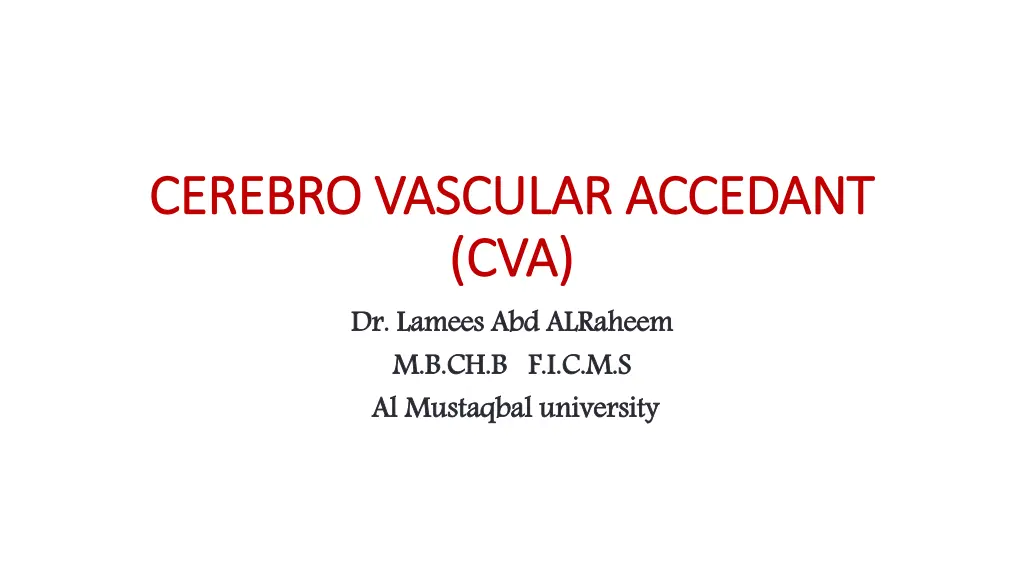
Understanding Cerebrovascular Accidents and Strokes
Learn about cerebrovascular accidents (CVAs), ischemic and hemorrhagic strokes, risk factors, classifications, and the Circle of Willis in the brain. Explore the different types of strokes, their causes, and implications on brain function.
Download Presentation

Please find below an Image/Link to download the presentation.
The content on the website is provided AS IS for your information and personal use only. It may not be sold, licensed, or shared on other websites without obtaining consent from the author. If you encounter any issues during the download, it is possible that the publisher has removed the file from their server.
You are allowed to download the files provided on this website for personal or commercial use, subject to the condition that they are used lawfully. All files are the property of their respective owners.
The content on the website is provided AS IS for your information and personal use only. It may not be sold, licensed, or shared on other websites without obtaining consent from the author.
E N D
Presentation Transcript
CEREBRO VASCULAR ACCEDANT CEREBRO VASCULAR ACCEDANT (CVA) (CVA) Dr. Lamees Abd ALRaheem M.B.CH.B Al Dr. Lamees Abd ALRaheem M.B.CH.B F.I.C.M.S Al Mustaqbal F.I.C.M.S university Mustaqbal university
CEREBRO VASCULAR ACCEDANT (CVA) CEREBRO VASCULAR ACCEDANT (CVA) Neurological deficit of cerebrovascular cause that persists beyond 24 hours . Transient ischemic attack (TIA), which is a related syndrome of stroke symptoms that resolve completely within 24 hours.
CLASSIFICATION Ischemic stroke Caused by interruption of the blood supply to the brain About 85% Hemorrhagic stroke hemorrhagic strokes result from the rupture of a blood vessel or an abnormal vascular structure About 15% The main risk factor for stroke is high blood pressure. Other risk factors include tobacco smoking, obesity, high blood cholesterol, diabetes mellitus, a previous TIA, end-stage kidney disease, and atrial fibrillation
Ischemic stroke Ischemic stroke In an ischemic stroke, blood supply to part of the brain is decreased, leading to dysfunction of the brain tissue in that area. There are four reasons why this might happen: Thrombosis (obstruction of a blood vessel by a blood clot forming locally). Embolism (obstruction due to an embolus from elsewhere in the body). Systemic hypoperfusion (general decrease in blood supply, e.g., in shock) Cerebral venous sinus thrombosis.
Hemorrhagic Stroke Hemorrhagic Stroke There are two main types of hemorrhagic stroke: Intracerebral hemorrhage, which is basically bleeding within the brain itself . Subarachnoid hemorrhage, which is basically bleeding that occurs outside of the brain tissue but still within the skull, and precisely between the arachnoid mater and pia mater. Hemorrhagic strokes may occur on the background of alterations to the blood vessels in the brain, such as cerebral AV malformation and an intracranial aneurysm, which can cause intraparenchymal or subarachnoid hemorrhage
Circle of willis Arterial circulation of the Brain
Neuroimaging Computed tomography (CT) scanning is the mainstay of emergency stroke imaging. It allows the rapid identification of intracerebral bleeding and stroke mimics (i.e. pathologies other than stroke that have similar presentations), such as tumors. Magnetic resonance imaging (MRI) scanning times are longer than CT, but MRI diffusion weighted imaging (DWI) can detect ischemia earlier than CT. it is more sensitive than CT in detecting strokes affecting the brainstem and cerebellum. Contraindications to MRI include cardiac pacemakers and claustrophobia on entering the scanner. CT angiography (CTA) and CT perfusion are now being used to characterize the cerebral circulation and areas of ischemia better .
Vascular imaging Vascular imaging Various techniques are used to obtain images of extracranial and intracranial blood vessels . The least invasive is ultrasound (Doppler or duplex scanning), which is used to image the carotid and the vertebral arteries in the neck. Can provided the degree of arterial stenosis and the presence of ulcerated plaques.
Blood flow in the intracerebral vessels can be examined using transcranial Doppler. Blood flow can also be detected by specialised sequences in MR angiography (MRA) or CTA but the anatomical resolution is still not as good as that of intra-arterial angiography, which outlines blood vessels by the injection of radio-opaque contrast intravenously or intra- arterially. Because of the significant risk of complications, intra-arterial contrast angiography is reserved for use when non-invasive methods have provided incomplete information, or when it is necessary to image the intracranial circulation in detail, e.g. to delineate a saccular aneurysm, an arteriovenous malformation or vasculitis.
Management Management Stroke unit Ideally, people who have had a stroke are admitted to a "stroke unit", a ward or dedicated area in a hospital staffed by nurses and therapists with experience in stroke treatment. Nursing care is fundamental in maintaining skin care, feeding, hydration, positioning, and monitoring vital signs such as temperature, pulse, and blood pressure.
Rehabilitation Stroke rehabilitation is the process by which those with disabling strokes undergo treatment to help them return to normal life as much as possible by regaining and relearning the skills of everyday living Medication Antiplatelet and statin in ischemic stroke, antibiotics in case of infection, treatment of the underlying cause with control of DM,HT.






















